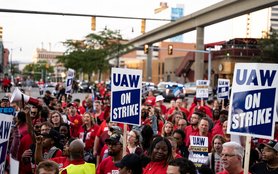On April 28, we mark Workers’ Memorial Day by remembering people who’ve been killed on the job. This grim milestone seems to get worse every year--as hazards multiply, and employers skirt responsibility while preferencing profits over workers’ health and safety. Is there a way for workers to push back on the abuses of corporate power?
Without a doubt, some jobs are inherently more dangerous than others, and the hazards vary wildly. You may work with sharp tools (meat and poultry processing), climb tall ladders (construction), or face heat and pesticides (agriculture).
And the last few years have added new hazards, stemming from the pandemic, climate change, and growing corporate power. You may be locked in during a tornado, or be working shoulder to shoulder with colleagues who are denied paid sick leave and show up with a transmissible virus. You may be exposed to a deadly chemical leak, or face enraged (and armed) customers.
When we mark Workers’ Memorial Day, we stop not only to think about the roughly 5,000 people who die on the job each year, but to ask what could have been done to prevent those deaths--and how to protect all workers, no matter the natural risks.
The answer is a lot. When the National Council for Occupational Safety and Health (COSH) announces its annual “Dirty Dozen” Unsafe Employers, it describes the exact hazards that workers face, and notes how simple (if not easy or cheap) it is to mitigate the dangers.
Employers can slow the pace of work to minimize repetitive strain injuries; provide shade, water, and rest to prevent heat illness; offer paid sick leave so workers can stay home when they’re ill (and infectious); follow all safety protocols on construction sites; and so on.
Or, despite the advances in 50 years since the Occupational Safety and Health Act went into effect, they may treat workers as another cost of doing business, and the math may make it easier to ignore hazards than to fix them.
Tapping racial dividing lines
Just as people from historically marginalized populations do a disproportionate share of the jobs that pay the least and offer the fewest opportunities, they also do more of the jobs that pose dangers--farming, landscaping, and construction, among others.
The most recent statistics from the Bureau of Labor Statistics indicate that fatalities declined in 2020 (from 5,333 to 4,764). To some extent, this can be attributed to the decline in workforce participation in a year when the pandemic shuttered large swaths of economic activity and unemployment rates skyrocketed.
However, at the same time, the disparity in injury and fatality rates by race grew even larger. While White workers account for 77% of the labor force, they account for only 60% of workplace fatalities; Hispanic or Latino workers account for 18% of the labor force but 22.5% of workplace deaths (1,072 in total, which represents the fourth straight yearly increase since 2016).
Moreover, fatality rates for Hispanic or Latino and Black workers keep steadily climbing, while rates for White workers decline (from 3,297 in 2019 to 2,898 in 2020).
The reasons are complex but clear: workers of color do the most dangerous jobs at the same time that they are paid low wages, earn little to no paid sick leave, and have access to poor healthcare coverage, if any. They were required to report to workplaces during the worst of the pandemic but enjoyed scant protection--at the same time that in many cases they lived in crowded situations and relied on public transportation.
Jessica Martinez, co-executive director of National COSH, notes that, “Fewer workers are now represented by unions, and many basic workplace protections have been eroded or eliminated. When our labor standards deteriorate, the most vulnerable workers suffer the most.”

Hope in worker power
While the last few years have posed extraordinary challenges for everyone, workers dubbed “essential” have been putting their lives on the line to keep systems running. And, not coincidentally, this is where there is new energy and hope for organizing workers into unions that would offer new power and protections.
We have seen a bold and vibrant wave of worker mobilization over the last year, with workers forming new unions, from the landmark win at Amazon’s 8,000-employee Staten Island warehouse to victories at several other companies.
This is growing directly from the roots of the pandemic--which revealed to everyone how little employers are willing to do to protect the health, safety, and dignity of workers--and grounded in the deeper soil of longstanding exploitation and ruthless shareholder capitalism that has long sought to minimize labor costs to maximize profits.
“Their contributions were not being rewarded sufficiently, and the risks they took were not being recognized sufficiently,” notes Stuart Applebaum, president of the Retail, Wholesale and Department Store Union (RWDSU). “Workers felt the callous indifference of too many employers. Plus, workers were concerned about the profiteering that was going on and the exponential explosion of income inequality.”
While the silver lining is hardly worth the price that countless workers paid over the past two years, maybe this year we can hope that workers are gathering in numbers and in bargaining strength, and will finally have enough power to demand more, and better.
_________________________________________________________________
Check out the National COSH report, and the site COSH created to tell worker stories about their conditions and organizing to fight back.



